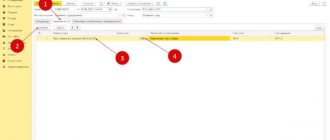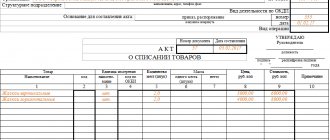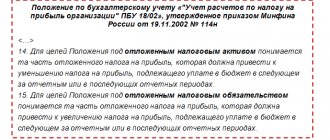When an intangible asset reaches the end of its regulated useful life, the asset is subject to write-off.
The general principles of such a procedure are provided for by PBU14/2007, namely, Chapter V of this normative act. The removal of an intangible asset from the balance sheet is documented and accompanied by recording of the necessary correspondence in accounting.
Acquisition and posting of intangible assets
To account for the acquisition of intangible assets, go to the menu “Fixed assets and intangible assets”, then “Intangible assets - Receipt of intangible assets”.
Fig.1 Receipt of intangible assets
The electronic document “Receipt of intangible assets” opens.
Fig.2 Electronic document “Receipt of intangible assets”
When you click the “Create” button, the “Receipt of intangible assets (creation)” document window will open (Fig. 3), in which you must fill in all the details sequentially. When selecting a counterparty, if only one agreement has been concluded with it, its details are entered automatically.
Fig.3 Receipt of intangible assets (creation)
We also fill in the remaining details sequentially. When you select an intangible asset, the directory menu “Intangible assets and R&D expenses” opens.
Fig.4 Intangible assets and R&D expenses
Click the “Create” button and sequentially fill in the directory details: full and short name of the intangible asset, group of objects, etc. (Fig. 5). In the line “Type of intangible assets”, 1C Accounting allows you to select the most suitable type of intangible assets for our case - Exclusive copyrights for computer programs (databases).
Fig.5 Exclusive copyright for computer programs (databases)
Also, when creating an intangible asset, you can immediately set its useful life by selecting a depreciation group (Fig. 6). Paragraph 1 of Article 258 of the Tax Code of the Russian Federation gives the taxpayer the right to independently determine the useful life of intangible assets and establish a depreciation group. In our example, we chose the fifth depreciation group with a useful life of 7 to 10 years.
Fig.6 Selecting a depreciation group
The cost of the software is 300.0 thousand rubles. Next, click “Pass and close” (Fig. 7). Please note that the program automatically entered intangible asset accounts 08.05 “Acquisition of intangible assets”.
Fig.7 Swipe and close
The registration of this document only reflects the receipt of intangible assets in 1C; the acceptance of intangible assets for accounting is formalized in a separate document with the same name. Below is a screenshot of the accounting entries generated when posting the document “Receipt of intangible assets”.
Fig.8 Receipt of intangible assets
Accounting for intangible assets (receipt)
Purchase of intangible assets (entries, example):
In accounting there is account 04 “Intangible assets”. Also, as in the case of fixed assets, intangible assets are accounted for at their original cost plus additional costs minus VAT. Moreover, since 2008, VAT has not been levied on the exclusive right to inventions, industrial designs, computer programs, databases, topologies of integrated circuits, know-how, and utility models. Additional costs may include payment of various duties, payment for the services of any intermediary organizations, payment for consulting and information services and other costs associated with the purchase of an intangible asset.
The primary documents for accounting for intangible assets are the Intangible Asset Accounting Card-1, and a transfer acceptance certificate is also drawn up.
Postings when purchasing an intangible asset:
| Debit | Credit | Operation name |
| 60 (76) | 51 | The cost of intangible assets has been paid |
| 08 | 60 (76) | The cost of the purchased intangible asset is taken into account |
| 19 | 60 (76) | VAT allocated |
| 08 | 60 (76) | All costs for the acquisition of intangible assets are taken into account |
| 04 | 08 | Intangible asset accepted for accounting |
Let's look at an example of how accounting is kept when purchasing an intangible asset, and what entries are made.
Example of purchasing an intangible asset:
Firm 1 bought the exclusive right to the invention from firm 2. The patent assignment agreement was registered with Rospatent with a fee of 2,400 rubles. The cost of the patent is 59,000 rubles.
In this example, the accounting entries will include the following:
| Sum | Debit | Credit | Operation name |
| 59000 | 60 | 51 | Patent cost paid |
| 59000 | 08 | 60 | The cost of the purchased patent is taken into account |
| 2400 | 08 | 60 | Duty payment included |
| 61400 | 04 | 08 | Intangible asset accepted for accounting |
Creation of an intangible asset (entry, example):
Intangible assets are considered created if they are received:
- As a result of the performance of official duties or for a specific assignment of the employer
- From outsiders under a concluded creation agreement.
Postings when creating intangible assets are similar to the previous case of purchase, only additional costs include payment for the services of employees of third-party organizations involved in the creation of intangible assets, payment for the labor of in-house specialists involved in the creation of intangible assets, deductions for social needs, costs of maintaining research equipment and other fixed assets involved in the creation of intangible assets, as well as accrued depreciation on them.
Example:
The research bureau developed a new engine, conducted successful tests, and sent an application for a patent to Rospatent.
Expenses:
- wages of employees 30,000;
- insurance premiums 7800;
- material costs 10,000;
- state duty 2000;
- examination fee 990.
The patent was received for 5 years.
Postings in this example:
| Sum | Debit | Credit | Operation name |
| 30000 | 08 | 70 | Employees' salaries taken into account |
| 7800 | 08 | 69 | UST allocated |
| 10000 | 08 | 10 | Material costs taken into account |
| 2000 | 60 | 51 | State duty paid |
| 990 | 60 | 51 | The examination fee has been paid |
| 2000 | 08 | 60 | Payment of state duty is taken into account |
| 990 | 08 | 60 | Payment of the fee for conducting the examination is taken into account |
| 50790 | 04 | 08 | Intangible asset accepted for accounting |
In this example, it is worth noting that this is how the accounting for intangible assets will look like in accounting, in tax accounting in accordance with Art. 257 of the Tax Code, taxes paid are not taken into account as costs when creating intangible assets.
We will discuss tax accounting in more detail later in the corresponding section of this site.
Receipt of an intangible asset in the form of a contribution to the authorized capital (posting):
If intangible assets are received by an enterprise as a contribution to the authorized capital, then remember account 75 and make the following entries:
D08 K75 - The cost of intangible assets is taken into account,
D04 K08 - Intangible asset accepted for accounting.
Acceptance of intangible assets for accounting
To carry out this operation, let’s move on to the document “Acceptance for accounting of intangible assets” of the subsection “Intangible assets” of the section “Fixed assets and intangible assets”.
Fig.9 Acceptance of intangible assets for accounting
In the window that opens, click the “Create” button. In the pop-up window, fill in the date of acceptance of the intangible asset for accounting (as a rule, this is the date of its acquisition), then click on the line “Method of receipt”. The program provides a wide range of ways to receive intangible assets, including a contribution to the authorized capital or receipt under a lease agreement. In our example, we select "Purchase with a fee."
Fig. 10 Purchase for a fee
Next, we directly select the intangible asset itself. A pop-up window allows you to select from the entire list of intangible assets the one that we want to take into account.
Fig. 11 Selecting an intangible asset
In the “Accounting” tab, you need to specify the parameters for calculating depreciation and select the method of its calculation (in our case, linear).
Fig. 12 Parameters for calculating depreciation
When you hover your cursor over the line “Method of reflecting depreciation expenses,” 1C allows you to select one of the provided accounts for attributing costs, or, if necessary, create one yourself.
Fig. 13 Method of reflecting depreciation expenses
In our example, we select account 20.01 “Main production”. We have determined the useful life to be 120 months. Depreciation of intangible assets in 1C is accrued from the month following the month of this document, after the implementation of the routine operation “Closing the month”.
Fig.14 Selecting an account and period
Also, when accepting intangible assets for accounting, it is necessary to fill out the “Tax Accounting” tab.
Fig. 15 Filling out the “Tax Accounting” tab
In this tab, fill in the fields for the value of intangible assets, its useful life, as well as the procedure for including the cost in expenses. In this case, the program provides three ways to enable it:
- Include in depreciable property;
- Include in expenses;
- Do not include as expenses.
Carrying out this document will entail the following accounting entry.
Fig. 16 Accounting entries
Amortization of intangible assets
depreciation of fixed assets
- Using account 05, on which depreciation is accumulated monthly. In this case, the entries for depreciation of intangible assets will look like this: D20 (44) K05 .
- By reducing the initial cost, when depreciation is written off directly from account 04, posting D20 (44) K04 .
Read more about the features of calculating depreciation of intangible assets in this article. Intangible assets can be revalued periodically to ensure that their accounting value corresponds to current reality. Read more about the revaluation of intangible assets here.
Write-off of intangible assets in 1C 8.3
The write-off, as well as the transfer of intangible assets, are reflected in 1C by drawing up the appropriate electronic documents: “Write-off of intangible assets” and “Transfer of intangible assets” in the “Intangible assets” section.
Fig. 17 Write-off of intangible assets
When writing off an intangible asset, the user only needs to select the type of expense, the program automatically enters the write-off account and the intangible asset itself (since we only have one).
Fig. 18 Select type of flow
When you click the “Other income and expenses” line, a window with established templates for write-off opens. If necessary, it is possible to introduce a new type of income or expense. In our example, we select “Other non-operating expenses and income.”
Fig. 19 Other non-operating expenses and income
The document “Transfer of Intangible Assets” formalizes the fact of sale of an intangible asset to a third party, therefore, unlike the document “Write-off of Intangible Assets” (Fig. 20), this document contains the necessary details of the counterparty, numbers and dates of the sales agreement, etc. to be filled in.
Fig. 20 Write-off of intangible assets
The program automatically creates income and expense accounts, which can be edited if necessary.
How to write off when closing an organization?
Cash and other assets of the closing (liquidated) organization remaining after the repayment of all creditor obligations are transferred legally to its founders (participants).
This norm is provided for by the Civil Code of the Russian Federation.
Since intangible assets, the legal holder of which is the liquidated organization, cannot be used in its business processes longer than the life of the organization itself, such assets are written off from the balance sheet when the enterprise is closed.
The following correspondence is compiled:
- The primary cost is written off.
- Accumulated depreciation is written off.
- The financial result of the write-off is reflected.
Inventory of intangible assets
In a general sense, inventory is a comparison of accounting data with their actual availability. When conducting an inventory of intangible assets, it is necessary to be guided by the requirements of paragraph 3.8 of Chapter 3 of the Inventory Rules (Order of the Ministry of Finance of the Russian Federation dated June 13, 1995), as well as PBU 14/2007 “Accounting for intangible assets.”
In the standard documents of the 1C program version 8.3 you will not find the electronic document “Inventory of intangible assets”, since it is believed that intangible assets are not subject to actual inventory. At the same time, if an organization has decided to take inventory of intangible assets, it is necessary to create an external report of the form “Inventory list of intangible assets (Inv-1a)”, which is created in the “Configurator” mode. The report generates balances in account 04 “Intangible assets” for all objects accepted for accounting.
Tax accounting
The specifics of tax accounting depend on what kind of object is being disposed of - a depreciable asset or, alternatively, a non-depreciable one.
For tax purposes, the depreciability of intangible assets is determined by its primary cost.
This circumstance makes tax accounting of this aspect significantly different from accounting.
If the primary cost of intangible assets is less than one hundred thousand rubles, such an object is not considered depreciable for tax accounting.
The costs of purchasing this asset are initially taken into account in other expenses of the organization related to production and sales.
If intangible assets are a depreciable object, the situation with tax accounting becomes somewhat more complicated.
When an intangible asset is written off because it has ceased to be used due to obsolescence, the costs of the write-off and the depreciation still subject to accrual are recorded as non-operating costs.
The sale/exchange of depreciable intangible assets causes a decrease in sales income (sales proceeds) by the residual value of disposed assets and sales costs.
Profit taxation in this case is carried out according to a typical scheme. The loss is subject to equal inclusion in other production/sales costs over the remaining period of operation of the facility.
Free transfer of HMA
This operation is performed at the calculated residual value. First, you need to write off depreciation, then add the rest of the amount to other expenses. If the intangible asset is subject to VAT, then VAT must be calculated from the sale price and entered into accounting.
| Debit | Credit | Sum | Operation | Document |
| 04.01 | Without VAT | Write-off of depreciation | Write-off act | |
| 91.02 | 04.01 | VAT INCLUDED | Writing off the cost of an object | Write-off act |
| 91.02 | 68.02 | VAT INCLUDED | VAT on the total written-off value | Write-off act |
| 99.09 | 91.09 | Without VAT | Lesion | Invoices, acts |
Entry of HMA into another company
When an intangible asset is transferred to another enterprise, for the enterprise this procedure is considered a financial investment and it will subsequently receive dividends. The transfer of an object can be carried out only at the residual value; first, depreciation is written off, and then the cost is determined and recorded in account 04. Also, in posting D58 K76 the debt on the deposit should be reflected, and in D76 K04 - the transfer of the object.
| Debit | Credit | Sum | Operation | Document |
| 58.01.1 | 76.05 | Without VAT | Debt on deposit | Act |
| 04.01 | Without VAT | Write-off of depreciation | Write-off act | |
| 76.05 | 04.01 | Without VAT | Transferring an object | Act |









